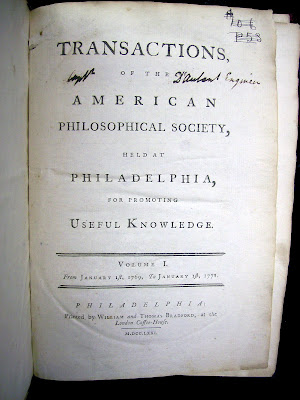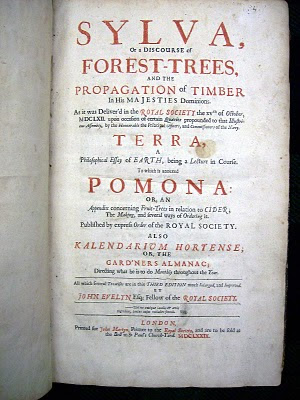
I recently had the opportunity to peruse a somewhat battered copy of Transactions, of the American Philosophical Society, Held at Philadelphia, for promoting Useful Knowledge, Volume 1, compiled between January 1st 1769 and January 1st 1771.
This particular book was printed by William and Thomas Bradford, a father and son firm in Philadelphia. William Bradford (1719–91) was born into a family of printers – don’t confuse him with his namesake grandfather (1663–1752), a colonial printer in Philadelphia and later in New York. (Grandfather Bradford is thought to have been the first printer in America to have fought a legal battle in defence of the freedom of the press. The trial, which took place in 1692, resulted in a hung jury, but contributed the Grandfather Bradford’s decision to leave Philadelphia for New York, where he later established the state’s first newspaper, the New York Gazette.)
Our William Bradford learned the trade from his uncle, Andrew Bradford, who was the only printer in Philadelphia from 1712 to 1723, and has the distinction of having briefly employed Philadelphia’s most celebrated printer and publisher, Benjamin Franklin (1706–90), when Franklin arrived in that town in 1723. On the completing his apprenticeship, William Bradford visited England in 1741, returning the next year with the equipment he needed to open his own shop. He became the printer of record for the first Continental Congress which met in Philadelphia in 1774, and was one of a number of printers who brazenly printed Thomas Jefferson’s Declaration of Independence in July 1776. He also served as colonel in the Pennsylvania militia during the American Revolution, leaving the business in the hands of his son Thomas. He was wounded at the Battle of Princeton and, though he lived until 1791, he never fully recovered. His dying words to his children are said to have been, “Though I bequeath you no estate, I leave you in the enjoyment of liberty.” No estate, eh? Seems some things about printing and publishing never change.

Introductions thus dispatched, there remain three threads to weave together in order to arrive at my point, and if I don’t proceed with the upmost brevity, I fear, dear reader, that I shall lose you entirely.
Thus:
1. The American Philosophical Society (whose proceedings, printed by Bradford, we consider here) was founded in 1743 by Benjamin Franklin. It fizzled and faltered within a year, but in January 1769 it was reborn and merged with the American Society for Promoting Useful Knowledge. Franklin was elected first president of the group and no doubt had a great deal of influence over the editing and publishing of this volume.
2. Benjamin Franklin, you may recall, started in the printing trade at a young age, fled to Philadelphia at the age of 17 to escape his apprenticeship to his older brother, and there was employed for a time by William Bradford's uncle. After gigging around Philadelphia printshops awhile, Franklin travelled to London to aquire printing equipment and further training on the strength of promises of support from Pennsylvania Governor Sir William Keith, support which never materialized. He was back in America by 1726 and began his career as a successful printer, publisher, author, inventor and statesman. What interests us at present, however, is the fact that between 1757 and 1763 Franklin was in England again, this time on a diplomatic mission on behalf of the elected assembly of Pennsylvania. He failed to effect the reforms he sought, but certainly profited by his time abroad. Such as joining the Birmingham-based Lunar Society, a sort of scientific salon which likely fueled Franklin’s later revival of his defunct American Philosophical Society. One of the people Franklin would have met at the Lunar Society was …
3. The legendary Birmingham printer and type designer John Baskerville (1706–75). Coming to printing in mid-life after a successful career as a writing master and Japaner of wares, Baskerville brooked no traditions and spared no expense, daring to ‘improve’ press, ink, and paper that they might better reproduce his new types design. His printing and types caused quite a stir when his books started emerging in 1757, the same year Franklin arrived in England. By and large, the English didn’t care for Baskerville’s type, preferring the late Baroque letterforms cut and cast by William Caslon (1692–1766). Critics said that Baskerville’s fine types and bright, smooth paper caused blindness. Franklin, however, loved Baskerville’s types, becoming Baskerville’s greatest advocate and booster, introducing his type to America.
And so, when I picked up this volume printed by a Philadelphia printer in 1771 and opened it at random to a page spread, I started and muttered to myself, Hey, isn’t that … BASKERVILLE?!

And so it was. Baskerville’s wonderful Neoclassical type shimmering across the pages of an American book, and the story of Franklin’s connection to it simmering in the background, giving context to the discovery. Was this useful knowledge, I wondered, thinking of the book’s title? What does it mean to make connections between such varied elements?

And a few more connections if you’ll permit me.
In a time when the decoration of book pages with boarders, rules, and fleurons ran rampant, Baskerville was known for his quiet design which, with a few exceptions, relied entirely upon the beauty of the typography. (This is one of the things I admire about his work.) While the first two pages from Bradford’s setting reproduced above take this model, many of Bradford’s pages tend to show a more decorative bent. Reproduced directly above, for example, is a chapter-ending bouquets of printer’s flowers and sorts.
Notice the capital I misused as a lowercase l in the word “Public” in line 7 of the text.

This page shows a strong French influence in its decoration. It seems to be emulating the design of the great punchcutter Pierre Simon Fournier (1712–68), whose neoclassical types share much affinity with Baskerville’s own, but whose pension for excessive decoration befuddles the modern eye. Fournier published his impressive two-volume Manuel Typographique in 1764 and 1768, and I wonder whether Bradford was familiar with it. Seeing the sorts he’s used to create these decorations, I wouldn’t be surprised to discover that the materials were imported from Fournier’s foundry.

More decoration. And you’ll notice the use of end punctuation in the heading, which was common at that time – an ugly convention we’ve since dropped.
Bradford, Franklin, Baskerville, Fournier … stories of political and typographic revolutions … not a bad little afternoon wander into the vast forest of the past, especially considering that the departure point was a book plucked at random from a library reshelving cart.
ANDREW STEEVES ¶ PRINTER & PUBLISHER

























